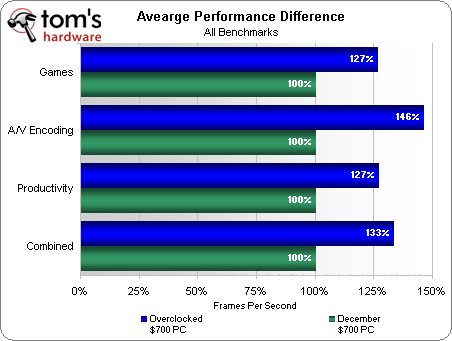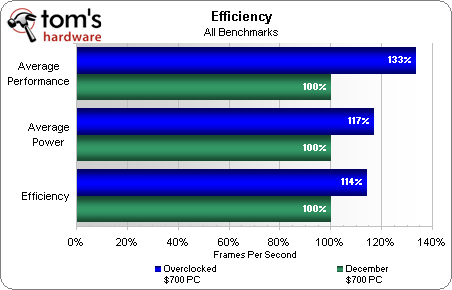System Builder Marathon, Dec. 2009: $700 Gaming PC
Conclusion
If you have read our Balanced Gaming PC series thus far, it should come as no surprise that the stock E5300 was limiting the gaming performance of today’s system. To be clear, this is not a configuration we would recommend for non-overclockers, as the platform is severely out of balance and in need of a more powerful CPU.
If you do not overclock, your money would be better spent utilizing the bundled cooler to free up funds for a more capable Pentium E6500, AMD Athlon II, or AMD Phenom II processor.
Of course, today’s system was specifically built to be overclocked, resulting in a respectable 33% increase in performance with just a 17% increase in average power consumption.
The question remains: did the overclocked system accomplish the goals we set out to reach? Win after win throughout the media encoding and productivity applications would certainly indicate it accomplished that goal, but a change to Windows 7 and updates to the benchmark suite prevent us from declaring it a clean sweep. And if application performance is truly what we seek, a processor capable of more simultaneous threads would often far outclass this highly overclocked dual-core CPU.
So how about games? After all, this is primarily a PC built for gaming. Thanks to a powerful pair of Radeon HD 4870 graphics cards, the overclocked December PC certainly provides the best high-resolution gameplay to date for a sub-$1,000 SBM machine. Priced at $250 for the pair, this graphics solution was the obvious choice to maximize our gaming dollar. But their inclusion presents an unfair advantage when comparing today's build to the September PC running Radeon HD 4850s in CrossFire. While both systems were easily playable, the previous AMD rig did offer the higher performance at lower settings and resolutions where we typically judge how CPUs measure up to one another.
Additional tests were run to verify and shine light on these somewhat surprising results. We found that swapping the RAM for high-performance DDR2-1066 offered a significant performance increase of 6% to 14% in each game. In the numbers generated, it seems our system limitation, most obvious at the lower settings, was more of a memory bottleneck than a CPU bottleneck. The gains from this RAM swap brought performance at least on par with the September PC at lower settings, while slightly increasing the lead it already held at the higher settings. Had we been able or had the time to maximize memory speed and timings, we may have been able to claim this overclocked system a total success.
But the fact still remains that the September PC, with its Phenom II X2 550 Black Edition and bundled cooler, flat out destroyed this system at stock speeds while also putting up the higher low-resolution numbers in four out of five games once overclocking came into play. If games are calling for more memory bandwidth than this relaxed DDR2-800 could deliver, then AMD’s on-die memory controller certainly looks to be an attractive route to take. We certainly aren’t discounting the incredible overclocking value we’ve enjoyed from the Pentium E5200 and E5300, but it’s likely that the budget-gaming PC in our next SBM will sport an affordable triple- or quad-core Socket AM3-based processor.
Get Tom's Hardware's best news and in-depth reviews, straight to your inbox.


